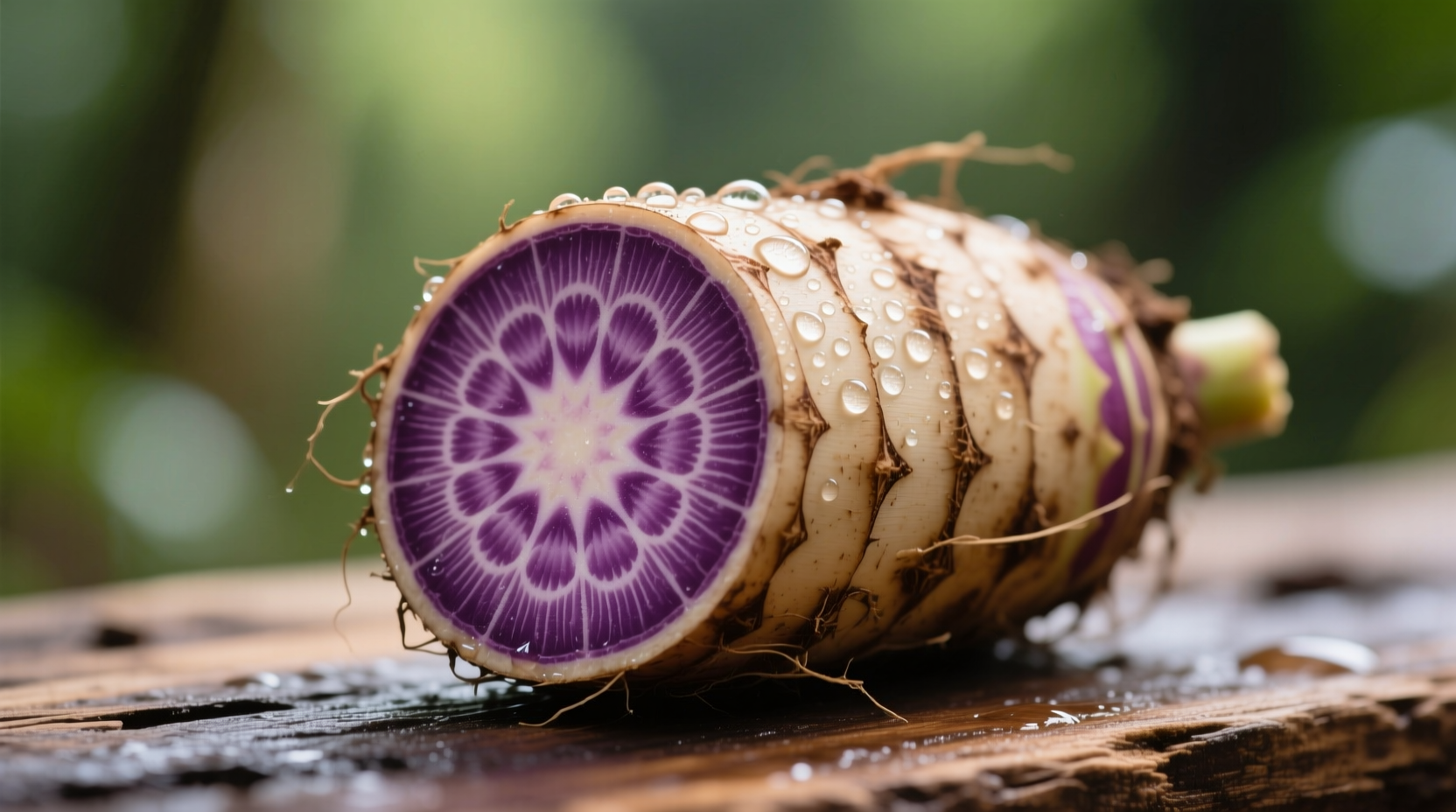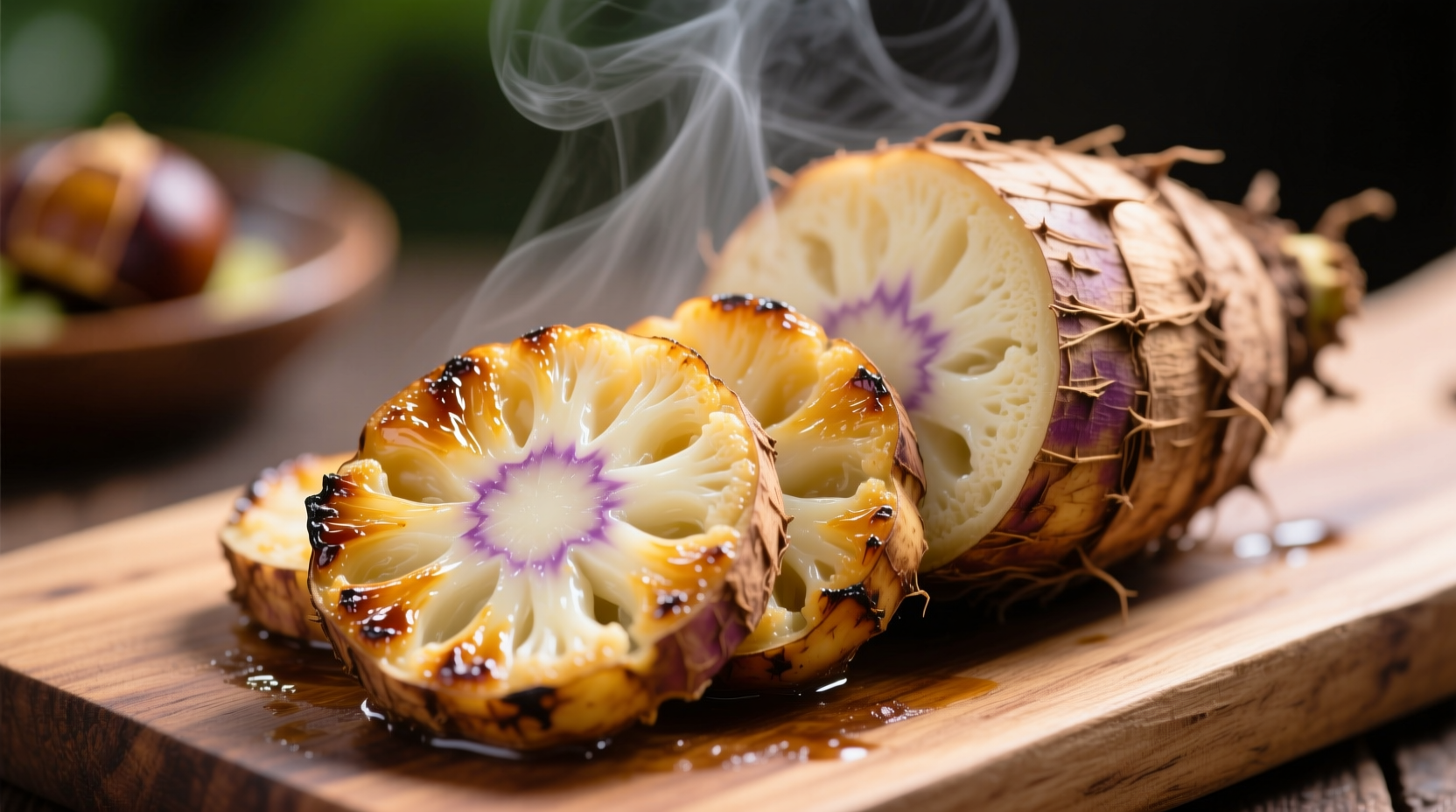Your Complete Guide to Taro's Unique Flavor Experience
When you bite into perfectly prepared taro, you'll first notice its delicate sweetness balanced by earthy notes reminiscent of chestnuts. Unlike overpowering root vegetables, taro offers a nuanced flavor profile that serves as a versatile canvas in global cuisines. This comprehensive guide reveals exactly what to expect from taro's taste across different preparations and cultural contexts.
Decoding Taro's Flavor Profile
Raw taro contains calcium oxalate crystals that cause irritation, so it's always consumed cooked. Once prepared properly, taro reveals its characteristic flavor:
- Sweetness level: Mild, natural sweetness (less intense than sweet potato)
- Primary notes: Nutty, earthy, with subtle vanilla undertones
- Texture: Creamy and dense when boiled, crispy when fried
- Aroma: Distinctive floral scent when cooked, especially in varieties like Dasheen
The specific taste experience varies significantly based on preparation method. Boiled taro maintains more of its earthy character, while roasted or fried versions develop richer caramelized notes. In bubble tea applications, taro's flavor becomes more pronounced and slightly sweetened through processing.
| Root Vegetable | Flavor Profile | Texture (Cooked) | Sweetness Level |
|---|---|---|---|
| Taro | Nutty, earthy, subtle vanilla | Creamy, dense | Mild |
| Sweet Potato | Distinctly sweet, caramel notes | Soft, moist | High |
| Yam | Earthy, slightly sweet | Dry, starchy | Low-Moderate |
| Potato | Neutral, earthy | Varieties differ | Very Low |
This comparison shows why taro occupies a unique position among root vegetables. Its distinctive flavor makes it irreplaceable in traditional dishes where substitution would alter the authentic taste experience. According to the USDA National Nutrient Database, taro's nutritional profile contributes to its flavor complexity with higher fiber content than potatoes and significant amounts of potassium and vitamin E.
How Cooking Transforms Taro's Taste
The preparation method dramatically impacts what taro tastes like. Understanding these transformations helps you achieve your desired flavor outcome:
Boiling (Most Common Method)
Boiling preserves taro's natural earthy notes while softening its texture. The water-soluble compounds create a slightly sweet broth often used in soups. For the most authentic what does taro taste like experience, boiling reveals its fundamental flavor profile without added ingredients.
Roasting
Roasting caramelizes taro's natural sugars, enhancing its sweetness and developing nuttier flavors. This method works particularly well for Colocasia esculenta varieties, bringing out subtle chestnut-like notes that make it a favorite in Hawaiian and Caribbean cuisines.
Frying
When sliced thin and fried, taro transforms into crispy chips with concentrated flavor. The high heat creates a unique texture contrast—crispy exterior with a slightly chewy interior—while intensifying its natural sweetness. This preparation is popular in Asian street food and explains why many people associate taro with the distinctive flavor of taro chips.
Steaming with Coconut Milk
In Pacific Islander and Southeast Asian preparations, steaming taro with coconut milk creates a luxurious texture while the coconut's sweetness complements taro's earthiness. This combination produces the characteristic flavor found in dishes like Hawaiian poi and Filipino laing.
Cultural Flavor Variations
Taro's taste profile adapts beautifully to regional culinary traditions. In Taiwan, taro is often paired with black sugar for bubble tea, creating a distinctive purple-hued drink with sweet, earthy notes. Hawaiian poi develops a slightly sour tang through traditional fermentation, while in West Africa, taro (called cocoyam) appears in spicy stews where its mild flavor balances bold seasonings.
The USDA Agricultural Research Service notes that different taro cultivars contain varying levels of phenolic compounds that influence their flavor profiles. Hawaiian varieties tend to have higher sugar content, while Asian cultivars often feature more pronounced earthy notes—important information for anyone exploring what does cooked taro taste like across different regional preparations.

Practical Flavor Tips for Home Cooks
When working with taro, keep these flavor-enhancing techniques in mind:
- Peel thoroughly: The skin contains bitter compounds that can affect taste
- Soak before cooking: Reduces residual calcium oxalate and improves texture
- Pair strategically: Complements coconut, ginger, and tropical fruits
- Avoid overcooking: Preserves texture and prevents flavor dilution
- Season after cooking: Taro absorbs flavors well but has its own distinctive taste
For those wondering how does taro taste compared to sweet potato, the key difference lies in taro's more complex flavor profile. While sweet potatoes deliver straightforward sweetness, taro offers layered notes of earthiness, nuttiness, and subtle floral hints that make it versatile across sweet and savory applications.
Common Flavor Misconceptions
Many commercial products labeled "taro flavor" actually use artificial flavoring that bears little resemblance to real taro. Authentic taro doesn't have the strong bubblegum-like taste found in some processed products. The natural color ranges from white with purple flecks to deep purple, but the flavor remains consistently mild and earthy regardless of color variation.
According to research published in the Journal of Food Science, the perception of taro's flavor can be influenced by accompanying ingredients. When paired with sugar, its earthy notes become less prominent, explaining why many associate taro primarily with sweet applications despite its culinary versatility.
Discovering Taro's True Flavor
To truly understand what taro tastes like, seek out fresh preparations rather than processed versions. Visit Asian or Pacific Islander markets for the widest variety of cultivars, and try it prepared in different ways. Start with simply boiled taro to appreciate its fundamental flavor before exploring more complex preparations. Remember that proper preparation is essential—undercooked taro retains irritating compounds, while overcooked taro loses its distinctive texture and flavor complexity.
Frequently Asked Questions
Does taro taste sweet or savory?
Taro has a naturally mild sweetness balanced by earthy, nutty notes, making it versatile for both sweet and savory applications. Its flavor profile leans slightly sweet when cooked simply, but it readily absorbs surrounding flavors, allowing it to work well in dishes ranging from desserts to stews.
How does taro compare to sweet potato in flavor?
Taro has a more complex flavor profile than sweet potato, with distinct nutty and earthy notes alongside its mild sweetness. Sweet potatoes deliver straightforward caramel-like sweetness, while taro offers subtle vanilla undertones and a creamier texture that works across both sweet and savory dishes.
Why does my taro taste bitter?
Bitterness in taro usually indicates improper preparation. Raw taro contains calcium oxalate crystals that cause irritation and bitter taste. Always peel thoroughly and cook taro completely—boiling for at least 20 minutes or until fork-tender neutralizes these compounds and reveals its characteristic mild, nutty flavor.
Does purple taro taste different from white taro?
The color variation in taro (from white to deep purple) primarily affects appearance rather than flavor. All varieties share the characteristic mild sweetness and nutty earthiness, though some cultivars may have slightly more pronounced vanilla notes. The purple color comes from anthocyanins, which don't significantly alter the fundamental taste profile.











 浙公网安备
33010002000092号
浙公网安备
33010002000092号 浙B2-20120091-4
浙B2-20120091-4